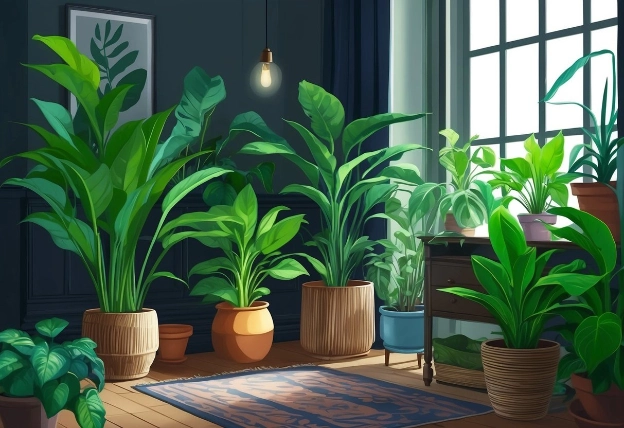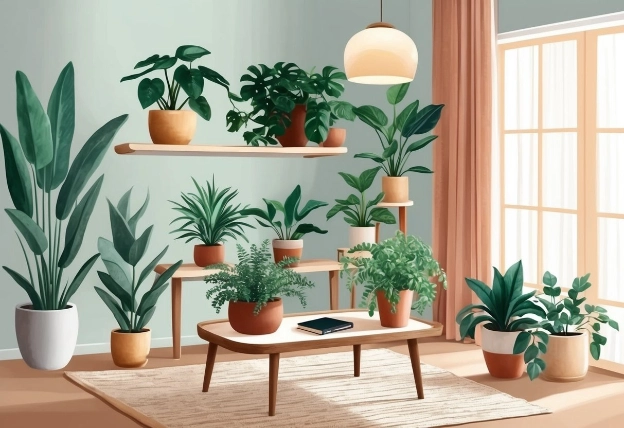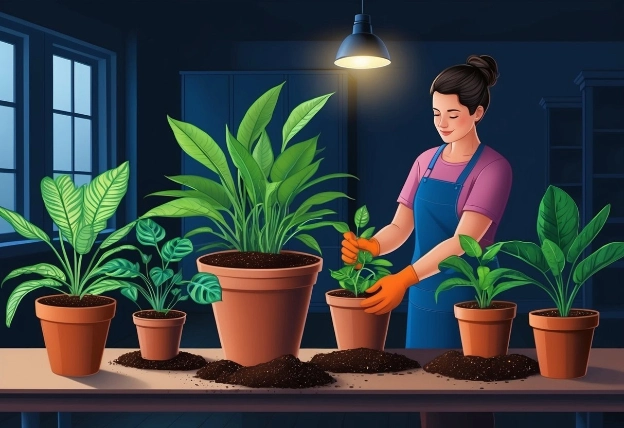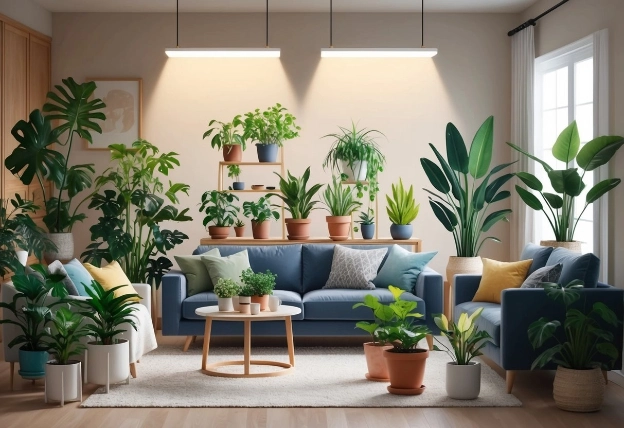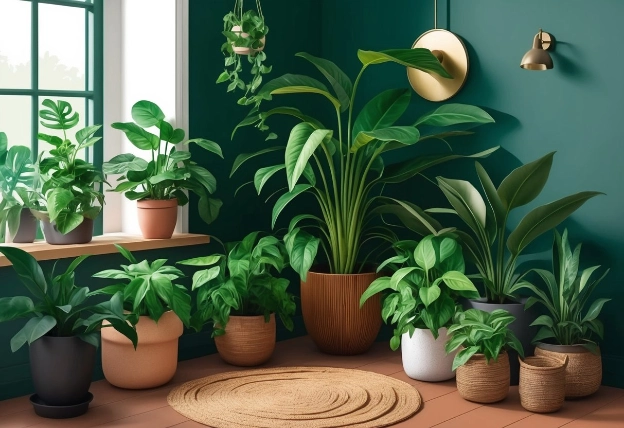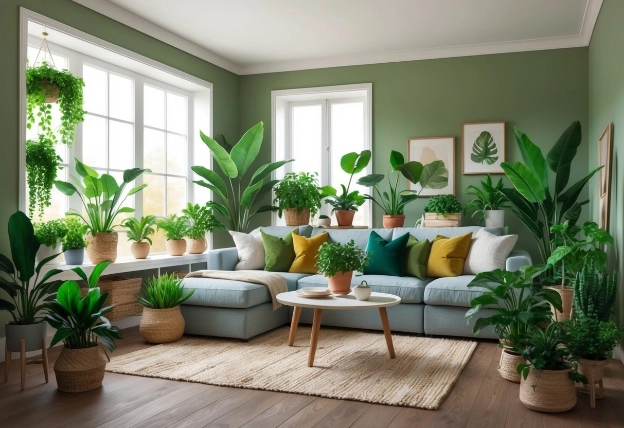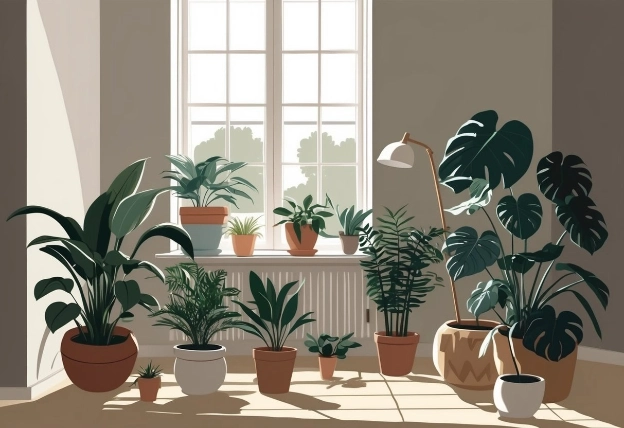Houseplants That Do Well in Low Light: Top 5 Shade-Loving Options
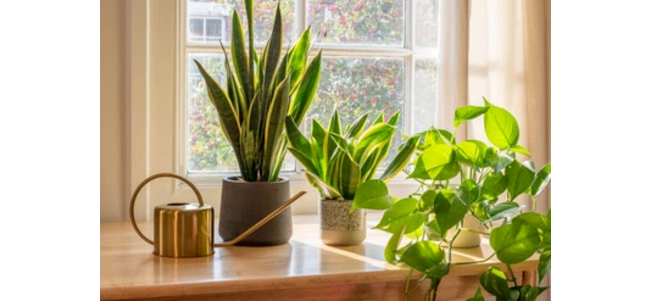
-
Your Home's Top 5 Shade-Loving Options
- Key Takeaways
-
Understanding Low Light Environments
- Defining Low-Light Conditions
- Advantages of Low-Light Houseplants
- Selecting the Right Houseplants for Low Light
- Criteria for Low-Light Houseplants
- Popular Low-Light Houseplants
- Caring for Low-Light Indoor Plants
- Watering Requirements
- Soil Preferences
- Fertilization and Pruning
- Propagation and Repotting
- Propagating Low-Light Plants
- Best Practices for Repotting
- Addressing Common Challenges
- Pest Management
- Disease Prevention
- Troubleshooting Growth Issues
- Enhancing Low Light with Artificial Solutions
- Using Grow Lights Appropriately
- Reflective Surfaces to Maximize Light
- Design and Aesthetic Considerations
- Creating Visual Impact with Houseplants
- Matching Plants with Decor
- Sustainability and Environmental Impact
- Choosing Eco-Friendly Houseplants
- Minimizing Carbon Footprint with Indoor Gardens
- Frequently Asked Questions
Disclosure: Some of the links in this article may be affiliate links, which can provide compensation to me at no cost to you if you decide to purchase. This site is not intended to provide financial advice and is for entertainment only.
Your Home's Top 5 Shade-Loving Options
Many people think they can't grow houseplants due to a lack of natural light. However, some plants thrive in low-light conditions. These plants can brighten up dim corners, bathrooms, and offices with little sunlight.
Low-light plants are perfect for spaces away from windows or in north-facing rooms. They've adapted to grow in shady forest floors. This means they need less light to photosynthesize and stay healthy.
Some top low-light plants include snake plants, ZZ plants, and pothos. These tough plants can handle neglect and less-than-ideal conditions. With the right care, they'll add life to any dark space in your home.
Key Takeaways
Many houseplants can thrive in low-light conditions
Low-light plants are ideal for dim spaces like bathrooms and offices
Snake plants, ZZ plants, and pothos are easy-care options for low-light
Understanding Low Light Environments
Low-light spaces can be great for certain houseplants. Some plants thrive with less sun. Let's examine what low light means and why it can benefit indoor plants.
Defining Low-Light Conditions
Low light refers to areas that get little direct sun. These spots are often far from windows or in rooms with small windows. North-facing windows provide low light all day. East or west windows can be low light if blocked by trees or buildings.
Some indoor spaces have no windows at all. Bathrooms, offices, and basements are often low-light areas. These spots may rely on artificial light from lamps or overhead fixtures.
Plants in low light get less than 3 hours of indirect sun daily. They may never see direct rays. But low light isn't the same as no light. Even low-light plants need some brightness to grow.
Advantages of Low-Light Houseplants
Low-light plants are perfect for many indoor spots, especially rooms that don't get much sun. These plants often need less care than sun-loving varieties.
Many low-light plants grow slowly. This means less pruning and repotting. They also tend to use less water. You won't have to water as often as plants in bright light.
Low-light plants can clean the air in dark corners and add green to spaces that might otherwise feel dull. Some low-light plants have striking leaves or interesting shapes.
These plants are good for busy people. They don't mind if you forget to water now and then. Many can survive on artificial light alone, ideal for offices or windowless rooms.
Selecting the Right Houseplants for Low Light
Picking plants that thrive in dim spaces can make indoor gardening easier. Some houseplants do well with less light and need less care.
Criteria for Low-Light Houseplants
Look for plants with broad, dark green leaves. These leaves help catch more light in dim areas. Slow-growing plants often do better in low light because they need less energy to grow.
Check if the plant is toxic before buying. Some low-light plants can harm pets or kids if eaten. Safe options include spider plants and parlor palms.
Think about the plant's water needs. Many low-light plants don't need much water, making them easier to care for. ZZ and snake plants are good choices for people who forget to water.
Popular Low-Light Houseplants
Peace lilies are great for low light. They have dark leaves and white flowers. Chinese evergreens come in many colors and grow well in dim rooms.
Snake plants are very tough. They can live in dark corners and need little water. Pothos vines grow long and can trail from shelves or baskets.
Monstera plants have big, pretty leaves. They do well in medium to low light. Dracaenas come in many types and sizes, and most can handle low light.
ZZ plants have shiny leaves and rarely need water, making them perfect for busy people. Philodendrons are easy to grow and come in climbing or bushy types.
Caring for Low-Light Indoor Plants
Low-light plants need specific care to thrive. These tips will help your shade-loving houseplants stay healthy and vibrant.
Watering Requirements
Most low-light plants need less water than their sun-loving counterparts. Check the soil moisture before watering. Stick your finger about an inch into the soil. If it feels dry, it's time to water.
Water thoroughly until it drains from the bottom. Empty the saucer so roots don't sit in water. Spathiphyllum (peace lilies) like moist soil but not soggy conditions. Let the top inch dry between waterings.
Peperomia plants store water in their thick leaves. They can go longer between waterings. Allow the soil to dry out more before watering again.
Soil Preferences
Well-draining soil is key for low-light plants. It prevents root rot from overwatering. To improve drainage, mix regular potting soil with perlite or sand.
Use a pot with drainage holes. This lets excess water escape. Some plants like Peperomia do well in small pots. This helps control moisture levels.
For orchids and bromeliads, use a special orchid mix. It allows airflow to the roots while retaining some moisture.
Fertilization and Pruning
Low-light plants grow slower, so they need less fertilizer. Feed them monthly during spring and summer with a balanced, water-soluble fertilizer. Use half the recommended strength.
When growth slows in fall and winter, stop fertilizing. Prune dead or yellowing leaves as needed. This keeps plants looking tidy and healthy.
For vining plants like pothos, trim long stems to encourage bushier growth. Then, you can root the cuttings to make new plants.
Propagation and Repotting
Growing more plants and giving them space to thrive are key skills for low-light plant care. These methods can help you expand your collection and keep your plants healthy.
Propagating Low-Light Plants
Many low-light plants are easy to propagate. Peace Lilies can be split at the roots when repotting. Gently separate the plant into smaller sections, each with roots and leaves.
Spider Plants produce small "pups" that can be cut off and planted. Place these baby plants in water or moist soil to grow roots.
Pothos and Philodendrons are simple to propagate from stem cuttings. Cut a stem with 2-3 leaves and put it in water. Roots will grow in a few weeks. Then, plant the cutting in the soil.
Best Practices for Repotting
Repot low-light plants every 2-3 years or when roots start coming out of drainage holes. Choose a pot 1-2 inches bigger than the current one.
Use a well-draining potting mix made for indoor plants. Gently remove the plant from its old pot. If the roots are tightly wound, loosen them.
Place the plant in the new pot at the same depth as before. Fill in with fresh soil. Water well after repotting.
Spring is the best time to repot peace lilies and spider plants, but pothos and Philodendrons can be repotted at any time of year.
Addressing Common Challenges
Growing low-light houseplants can present some obstacles. To keep your plants healthy, let's look at handling pests, preventing diseases, and fixing growth problems.
Pest Management
Pests can be a nuisance for low-light plants like Snake Plants and golden pothos. Check leaves regularly for signs of insects. Wipe leaves with a damp cloth to remove dust and pests. Use a neem oil spray for spider mites. Treat fungus gnats by letting the soil dry between waterings. Sticky traps can catch flying pests.
If you spot mealybugs on your Hoya, dab them with rubbing alcohol. For scale insects on Sansevieria, scrape them off gently. Always isolate infected plants to stop pests from spreading.
Disease Prevention
Low-light conditions can make plants more prone to diseases. Good airflow helps prevent fungal issues. Don't overwater—it leads to root rot. Use well-draining soil for Snake Plants and Sansevierias.
Remove dead or yellow leaves promptly. This stops diseases from spreading. Clean your tools between plants to avoid cross-contamination. If you see signs of disease, act fast. Cutaway infected parts with clean scissors.
For powdery mildew on Golden Pothos, try a mix of water and baking soda as a spray.
Troubleshooting Growth Issues
Slow growth is common in low light, but extreme issues need attention. Pale leaves often mean too little light - move the plant closer to a window. If leaves turn yellow, you might be overwatering. Let the soil dry out more between waterings.
Brown leaf tips on Snake Plants can signal too much fluoride in water. Use filtered water instead. For leggy growth on Golden
Pothos prune regularly to encourage business.
If your Hoya isn't flowering, it may need more bright, indirect light. Sansevierias with soft, mushy leaves are likely overwatered. Let the soil dry completely and reduce watering.
Enhancing Low Light with Artificial Solutions
Plants need light to grow. When natural light is limited, artificial solutions can help houseplants thrive. These methods boost light levels and create better growing conditions.
Using Grow Lights Appropriately
Grow lights are a great way to give plants the light they need. LED grow lights work well and use less energy than other types. Place grow lights 6-12 inches above plants. Keep lights on for 12-16 hours a day.
Different plants need different amounts of light. Succulents and herbs often need more light than shade-loving plants. Adjust the distance and time based on each plant's needs.
Look for signs that plants are getting enough light. Healthy leaf color and growth show the light is right. Move lights closer if plants look stretched out.
Reflective Surfaces to Maximize Light
Reflective surfaces can bounce light onto plants, helping them make the most of both natural and artificial light. White walls and mirrors reflect light well.
Place plants near light-colored surfaces when possible. Shiny objects like foil or mylar are used to direct light. These work well behind grow lights or in corners.
Reflective plant saucers under pots can boost light from below, and light-colored furniture near plants can help, too. Even small changes can make a big difference for low-light plants.
Design and Aesthetic Considerations
Low-light houseplants can greatly enhance interior spaces. They add natural beauty and create a calming atmosphere, even in darker areas of the home.
Creating Visual Impact with Houseplants
Use plants of different sizes to create visual interest. Place taller plants like Monstera Adansonii in corners or behind furniture. Add smaller plants like Nerve Plants on shelves or tabletops.
Group plants together for a lush, jungle-like feel. Mix plants with different leaf shapes and textures. Pair large-leaved Monsteras with delicate English Ivy for contrast.
Decorative pots add color and style. Choose pots that match your decor or make a statement with bold colors or patterns.
Matching Plants with Decor
Select plants that complement your existing decor. For modern spaces, choose plants with clean lines, like snake plants. For bohemian styles, opt for trailing plants like English Ivy.
Use plants to add pops of color. Fittonias, known as Nerve Plants, come in pink, red, and white varieties. They can brighten up dark corners or add interest to neutral color schemes.
Consider plants' growth habits. Trailing plants work well in hanging baskets or on high shelves, while upright plants can fill empty floor spaces or act as living room dividers.
Sustainability and Environmental Impact
Low-light houseplants can boost sustainability and reduce environmental impact. They clean indoor air and create green spaces with minimal resource use.
Choosing Eco-Friendly Houseplants
Lucky Bamboo is a top eco-friendly choice. It grows in water, reducing soil and fertilizer needs. This plant uses few resources and lasts for years with basic care.
Swiss Cheese Plants are also great picks. They grow slowly in low light and need less frequent repotting or pruning, which means less waste over time.
Spathiphyllum, or Peace Lily, is known for its air-cleaning abilities. It removes common indoor pollutants, making homes healthier without using extra energy.
Minimizing Carbon Footprint with Indoor Gardens
Indoor plants, especially tropical varieties, can cut energy costs. They add moisture to the air, reducing the need for humidifiers in dry climates.
Plants act as natural air filters, which can reduce the use of electric air purifiers, saving energy and reducing carbon emissions.
Growing plants indoors reduces the carbon footprint linked to transporting store-bought plants. It also reduces plastic waste from pots and packaging.
Indoor gardens can be watered with collected rainwater or recycled household water, conserving resources and lowering water bills.
Frequently Asked Questions
Low-light plants come in many sizes and varieties. Some thrive in dark rooms, while others are safe for pets. Choosing the right plants for your space depends on size and light levels.
What are the optimal large houseplants that thrive in low light conditions?
Snake plants and ZZ plants grow tall in low light. Monstera deliciosa can reach impressive sizes even without bright sun. Chinese evergreens also do well and can grow quite large over time.
Can you list small houseplants that are suitable for poorly lit areas?
Pothos and philodendrons are compact vines that stay small in low light. Prayer plants and peace lilies remain petite. Spider plants also stay small and adapt well to dim conditions.
Which indoor plants are best suited for dark rooms?
Cast iron plants live up to their name in very dark spots. Snake plants and ZZ plants tolerate extremely low light. Pothos vines can survive with minimal light as well.
Are there any low-light plants that are safe for pets, particularly cats?
Spider plants, Boston ferns, and parlor palms are nontoxic to cats. African violets and Christmas cacti are also pet-safe options for low-light areas. Always check before bringing new plants home.
How do I choose the right low-light plants for an office environment?
Look for plants that don't need much care. Snake plants, ZZ plants, and pothos are low-maintenance. Consider desk-sized plants like small ferns or compact palms that won't take up too much space.
What varieties of low light indoor trees can adapt to indoor conditions?
Umbrella trees and rubber plants grow tall in low light. Dracaena varieties like corn plants or dragon trees can become tree-like. Ficus trees, especially the fiddle leaf fig, adapt well to indoor spaces with less light.
-
Your Home's Top 5 Shade-Loving Options
- Key Takeaways
-
Understanding Low Light Environments
- Defining Low-Light Conditions
- Advantages of Low-Light Houseplants
- Selecting the Right Houseplants for Low Light
- Criteria for Low-Light Houseplants
- Popular Low-Light Houseplants
- Caring for Low-Light Indoor Plants
- Watering Requirements
- Soil Preferences
- Fertilization and Pruning
- Propagation and Repotting
- Propagating Low-Light Plants
- Best Practices for Repotting
- Addressing Common Challenges
- Pest Management
- Disease Prevention
- Troubleshooting Growth Issues
- Enhancing Low Light with Artificial Solutions
- Using Grow Lights Appropriately
- Reflective Surfaces to Maximize Light
- Design and Aesthetic Considerations
- Creating Visual Impact with Houseplants
- Matching Plants with Decor
- Sustainability and Environmental Impact
- Choosing Eco-Friendly Houseplants
- Minimizing Carbon Footprint with Indoor Gardens
- Frequently Asked Questions
Disclosure: Some of the links in this article may be affiliate links, which can provide compensation to me at no cost to you if you decide to purchase. This site is not intended to provide financial advice and is for entertainment only.

